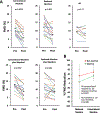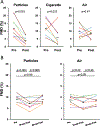Impairment of Endothelial Function by Cigarette Smoke Is Not Caused by a Specific Smoke Constituent, but by Vagal Input From the Airway
- PMID: 36288292
- PMCID: PMC9616206
- DOI: 10.1161/ATVBAHA.122.318051
Impairment of Endothelial Function by Cigarette Smoke Is Not Caused by a Specific Smoke Constituent, but by Vagal Input From the Airway
Abstract
Background: Exposure to tobacco or marijuana smoke, or e-cigarette aerosols, causes vascular endothelial dysfunction in humans and rats. We aimed to determine what constituent, or class of constituents, of smoke is responsible for endothelial functional impairment.
Methods: We investigated several smoke constituents that we hypothesized to mediate this effect by exposing rats and measuring arterial flow-mediated dilation (FMD) pre- and post-exposure. We measured FMD before and after inhalation of sidestream smoke from research cigarettes containing normal and reduced nicotine level with and without menthol, as well as 2 of the main aldehyde gases found in both smoke and e-cigarette aerosol (acrolein and acetaldehyde), and inert carbon nanoparticles.
Results: FMD was reduced by all 4 kinds of research cigarettes, with extent of reduction ranging from 20% to 46% depending on the cigarette type. While nicotine was not required for the impairment, higher nicotine levels in smoke were associated with a greater percent reduction of FMD (41.1±4.5% reduction versus 19.2±9.5%; P=0.047). Lower menthol levels were also associated with a greater percent reduction of FMD (18.5±9.8% versus 40.5±4.8%; P=0.048). Inhalation of acrolein or acetaldehyde gases at smoke-relevant concentrations impaired FMD by roughly 50% (P=0.001). However, inhalation of inert carbon nanoparticles at smoke-relevant concentrations with no gas phase also impaired FMD by a comparable amount (P<0.001). Bilateral cervical vagotomy blocked the impairment of FMD by tobacco smoke.
Conclusions: There is no single constituent or class of constituents responsible for acute impairment of endothelial function by smoke; rather, we propose that acute endothelial dysfunction by disparate inhaled products is caused by vagus nerve signaling initiated by airway irritation.
Keywords: acetaldehyde; acrolein; carbon; menthol; nanoparticles.
Figures




Comment in
-
How Irritating! Electronic Cigarettes Not "95% Safer" Than Combustible Cigarettes: Recent Mechanistic Insights Into Endothelial Dysfunction.Arterioscler Thromb Vasc Biol. 2022 Nov;42(11):1351-1354. doi: 10.1161/ATVBAHA.122.318468. Epub 2022 Oct 26. Arterioscler Thromb Vasc Biol. 2022. PMID: 36288291 Free PMC article. No abstract available.
References
-
- Celermajer DS, Sorensen KE, Georgakopoulos D, Bull C, Thomas O, Robinson J, Deanfield JE. Cigarette smoking is associated with dose-related and potentially reversible impairment of endothelium-dependent dilation in healthy young adults. Circulation. 1993;88:2149–2155. - PubMed
-
- Celermajer DS, Adams MR, Clarkson P, Robinson J, McCredie R, Donald A, Deanfield JE. Passive smoking and impaired endothelium-dependent arterial dilatation in healthy young adults. N Engl J Med. 1996;334:150–154. - PubMed
-
- Kato T, Inoue T, Morooka T, Yoshimoto N, Node K. Short-term passive smoking causes endothelial dysfunction via oxidative stress in nonsmokers. Can J Physiol Pharmacol. 2006;84:523–529. - PubMed
-
- Carnevale R, Sciarretta S, Violi F, Nocella C, Loffredo L, Perri L, Peruzzi M, Marullo AG, De Falco E, Chimenti I, et al. Acute Impact of Tobacco vs Electronic Cigarette Smoking on Oxidative Stress and Vascular Function. Chest. 2016;150:606–612. - PubMed

